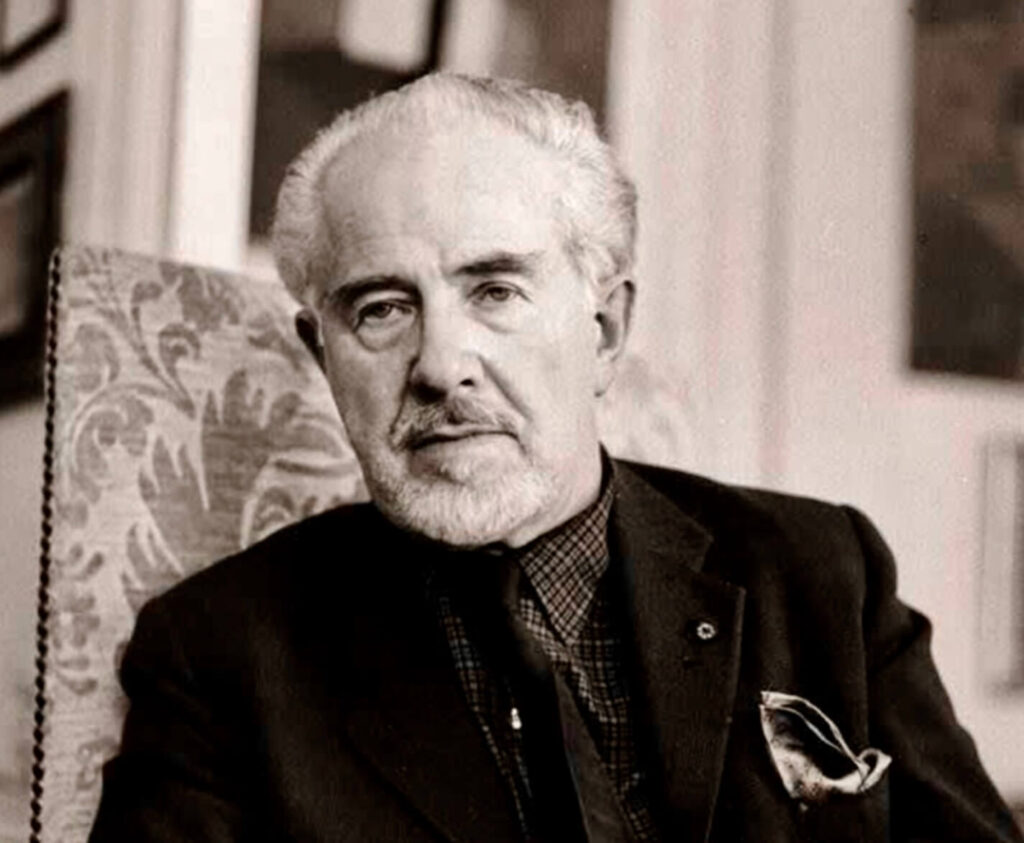Mark Tobey
Mark Tobey (1890-1976) was a pivotal figure in American art, known for his intricate abstract compositions and his role in the development of the Northwest School of artists. His unique style, which blended Eastern and Western artistic traditions, set him apart from his contemporaries and left a lasting impact on modern art. This biography will explore Tobey’s life, career, and one of his most important artworks, “White Journey,” showcasing his contributions to the art world.

Early Life and Education
Mark Tobey was born on December 11, 1890, in Centerville, Wisconsin. From a young age, he displayed a keen interest in drawing and painting. His family moved to Chicago in 1893, where Tobey attended public schools and later studied at the Art Institute of Chicago. Although his formal education in art was limited, Tobey was an avid learner and drew inspiration from various sources, including museums and art classes.
In 1911, Tobey moved to New York City, where he initially worked as a fashion illustrator. During this period, he immersed himself in the vibrant art scene, meeting and interacting with artists, writers, and musicians. His exposure to diverse artistic movements, including Cubism, Futurism, and Surrealism, greatly influenced his developing style.
Spiritual Exploration and Artistic Development
A significant turning point in Tobey’s life came in 1918 when he converted to the Bahá’í Faith. The spiritual principles of the Bahá’í Faith, which emphasize the unity of all religions and the oneness of humanity, profoundly impacted Tobey’s worldview and artistic vision. He began to incorporate these principles into his work, seeking to express the interconnectedness of all things through his art.
In the 1920s, Tobey moved to Seattle, where he became involved with the Cornish School of the Arts. There, he met the painter and mystic Morris Graves, with whom he formed a close friendship. Tobey’s interest in Eastern philosophies and calligraphy deepened during this time, further shaping his artistic direction.
In 1934, Tobey traveled to Europe and the Middle East, spending time in England, France, and Lebanon. His encounters with Islamic and Asian art, particularly Chinese calligraphy, had a lasting impact on his work. Upon his return to the United States, Tobey began to develop his signature style, known as “white writing,” which would come to define his career.
The Birth of White Writing
Tobey’s “white writing” technique involved the use of intricate, interwoven lines and shapes, often applied in white or light-colored paint over darker backgrounds. This style, inspired by Chinese calligraphy and Islamic scripts, created a sense of movement and rhythm, evoking the spiritual and cosmic themes that were central to Tobey’s work.
In the late 1930s and early 1940s, Tobey’s white writing began to gain recognition. His works were exhibited in several prominent galleries, and he received critical acclaim for his innovative approach. Tobey’s painting “Broadway” (1936), for instance, captures the bustling energy of New York City through a dense network of lines and shapes, illustrating his ability to transform everyday scenes into abstract compositions.
International Acclaim and Recognition
The 1950s marked a period of international acclaim for Tobey. His works were featured in major exhibitions, including the Venice Biennale in 1958, where he was awarded the International Grand Prize in Painting. Tobey’s success in Europe further solidified his reputation as a leading figure in abstract art.
During this time, Tobey also traveled extensively, spending time in Japan, where he studied Zen Buddhism and Japanese calligraphy. These experiences further enriched his artistic practice, leading to a deeper integration of Eastern and Western influences in his work.
Important Artwork: “White Journey” (1956)
One of Mark Tobey’s most significant and celebrated works is “White Journey” (1956), a painting that exemplifies his mastery of the white writing technique and his exploration of spiritual and cosmic themes.
“White Journey” (1956)
“White Journey” is a large-scale painting that features a complex, interwoven network of white lines and shapes set against a dark background. The composition is both intricate and harmonious, with each line and form contributing to the overall sense of movement and rhythm. The painting’s dynamic energy and flowing patterns evoke a sense of spiritual transcendence, reflecting Tobey’s belief in the interconnectedness of all things.
The white lines in “White Journey” are applied with a calligraphic precision, creating a delicate balance between order and chaos. The painting’s layered composition invites viewers to explore its depths, revealing new details and patterns with each closer inspection. This sense of depth and complexity is a hallmark of Tobey’s work, illustrating his ability to convey profound ideas through abstract forms.
“White Journey” is significant not only for its artistic merits but also for its broader cultural implications. The painting embodies Tobey’s synthesis of Eastern and Western artistic traditions, showcasing his ability to bridge diverse influences and create a unique visual language. Its spiritual themes and abstract forms continue to resonate with viewers, making “White Journey” a testament to Tobey’s enduring legacy.
Later Career and Continued Innovation
Throughout the 1960s and 1970s, Tobey continued to push the boundaries of his artistic practice. He experimented with new materials and techniques, incorporating elements such as collage and mixed media into his works. His paintings from this period often feature a more subdued color palette, with an emphasis on texture and form.
In 1960, Tobey moved to Basel, Switzerland, where he lived for the remainder of his life. His time in Europe allowed him to engage with a broader artistic community and to continue his exploration of spiritual and cosmic themes. Tobey’s later works, such as “Edge of August” (1970), reflect a mature refinement of his white writing technique, with a focus on subtle variations in color and texture.
Despite his international success, Tobey remained deeply connected to the Pacific Northwest, where he had spent much of his early career. His influence on the region’s art scene is evident in the work of younger artists, including Morris Graves, Guy Anderson, and Kenneth Callahan, who collectively became known as the Northwest School.
Personal Life and Philosophy
Mark Tobey’s personal life was marked by his spiritual quest and his dedication to his art. He was known for his introspective nature and his deep commitment to exploring the mysteries of existence through his work. Tobey’s interest in various religious and philosophical traditions, including the Bahá’í Faith, Buddhism, and Sufism, informed his artistic vision and provided a rich source of inspiration.
Tobey’s artistic philosophy was rooted in the belief that art could transcend cultural and linguistic barriers, conveying universal truths through abstract forms. He viewed his paintings as meditative spaces, inviting viewers to engage with the deeper dimensions of reality. This approach is evident in the contemplative quality of his work, which often evokes a sense of quiet introspection and spiritual reflection.
Legacy and Influence
Mark Tobey’s legacy as an artist lies in his ability to create a unique visual language that bridges diverse cultural and artistic traditions. His innovative white writing technique and his exploration of spiritual and cosmic themes have left a lasting impact on modern art, influencing generations of artists and viewers.
Tobey’s works are included in the collections of major museums and galleries around the world, including the Museum of Modern Art in New York, the Smithsonian American Art Museum in Washington, D.C., and the Tate Gallery in London. His contributions to abstract art and his role in the development of the Northwest School continue to be celebrated through exhibitions and retrospectives.
Since his death on April 24, 1976, Tobey’s work has continued to inspire new generations of artists and viewers. His ability to convey profound spiritual themes through abstract forms remains a testament to his talent and vision. Tobey’s legacy as a pioneer of abstract art and a bridge between Eastern and Western artistic traditions ensures that his work will continue to resonate with audiences for years to come.
Conclusion
Mark Tobey’s artistic journey is a testament to his creativity, resilience, and profound understanding of form and material. Through his innovative white writing technique, he created a body of work that continues to inspire and challenge viewers. “White Journey,” one of his most important works, exemplifies his ability to convey complex ideas and emotions through abstract forms and dynamic compositions. Tobey’s legacy as a sculptor is a reminder of the transformative power of art and the enduring impact of creative vision.



